
A fist is a hand which has its fingers and thumbs retracted by curling them into the palm. Forming a hand into this shape displays the knuckles thereby augmenting the injury one inflicts by thrusting one's hand forward, a maneuver known as punching.
As a result, using fists is one of the most rudimentary forms of combat and the basic means by which a human individual can fight unarmed. With sufficient force and intensity, a individual may beat another to death with his own fists by inflicting blunt force trauma. However, unarmed combat is also among the most non-lethal means of combat; street fighters and Assassins who do not wish to deal permanent harm to their adversaries may defer to pure fisticuffs to knock them unconscious instead.
History
Middle Ages
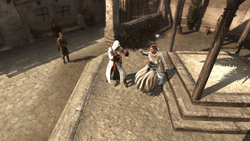
Altaïr Ibn-La'Ahad could use his fists to fight or stun enemies at any time, though they were significantly ineffective against armed opponents, as Altaïr could not perform combo kills or counterattacks as with any other weapon; he also could not block sword strikes nor dodge attacks while wielding fists.[1]
Because of their rank, novice Assassins were not allowed to carry weapons, and thus needed to avoid fights or resort to using their fists. Higher-ranked Assassins also used unarmed fighting to interrogate a _target, or after being caught by thugs while attempting to pickpocket throwing knives.[1]
Using fists in a fight against civilians also did not raise suspicion with the guards, who would only intervene if they themselves were attacked or if the Assassin drew their weapon during the fight.[1]
Renaissance
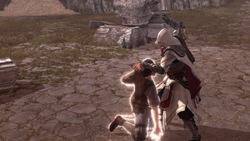
Ezio Auditore da Firenze was highly skilled in fist-fighting, and was likely taught by his brother, Federico. The two were once embroiled in a brawl against Vieri de' Pazzi and his men, where all present used only their fists.[2]
When unarmed, Ezio could perform many different combination strikes, counter other fist-fighters, and throw sand in their faces. He also learned to disarm foes and use their weapons against them,[2] eventually learning to kill them in one swift move right after doing so. However, Ezio could not chain together kills with his fists like he could with other melee weapons.[3]
Fists also became a more viable option for combat when the Metal Cestus, a hard steel hand-guard, was purchased from blacksmiths.[2]
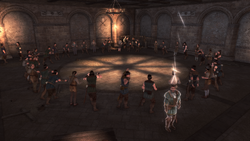
Guards eventually learned to throw sand in Ezio's face as well, though unlike him they could do so while still holding onto their weapons. Ezio could only perform the same move with his weapon equipped as long as he had no bullets or throwing knives left.[3]
Additionally, the Caserma di Alviano played host to a Fight Club, where mercenaries competed in unarmed fighting. Ezio was able to participate in the fights, on Bartolomeo d'Alviano's suggestion, in order to improve his skills with his fists.[3]
Golden Age of Piracy
In the years between 1715 and 1722, Edward Kenway would fight several brutes present at local taverns and bars throughout the West Indies in order to gain access to the establishment's bartender, who would then provide him with information concerning naval convoys or hidden treasure maps.[4]
American Revolution
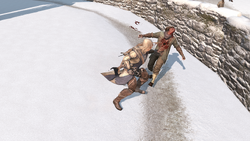
Haytham Kenway and Ratonhnhaké:ton were skilled fighters, although their styles were different from Ezio's or Altaïr's. They would frequently use the environments to their advantage, such as glass bottles and breakable barrels. Unlike Ezio, who had a more elegant style to his fist-fighting, Haytham and Ratonhnhaké:ton fought with a more ruthless and powerful form. They were more than capable of snapping bones, as well as knocking people to the floor.[5]
Ratonhnhaké:ton was invited to join a fight club known as the Boston Brawlers, who were having a tournament at the time. Throughout several fights around the colonies, he ranked higher and higher until he was allowed to participate in the competition. At the end, Ratonhnhaké:ton became the new champion of the Boston Brawlers, but did not participate in their fights following.[5]
Victorian era
Due to strict regulations on open possession of weapons, the majority of conflicts between criminal gangs were drawn out with fistfights, although some incorporated brass knuckles as well.[6]
The Assassin twins Jacob and Evie Frye participated in fight clubs run by the bookie Robert Topping. After winning all of the rounds at each location, as well as completing Robert's races, he rewarded them with some powerful cane-swords.[6]
Modern times
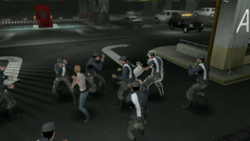
Upon escaping Abstergo Industries with Lucy Stillman, Desmond Miles did not wield a weapon and was forced to fist-fight the Abstergo security officers attempting to detain him.[2]
Though his abilities were initially rather limited, over time he was able to gain Ezio's fist-fighting skills through the Bleeding Effect. After this, he became able to perform counters and disarm his enemies.[2]
Later, after reliving the memories of Ratonhnhaké:ton, Desmond's fighting style began to closely mimic his new ancestor's. He would fight with much more strength and could take down several guards quickly and fluidly.[5]
Trivia
- The achievement "Messer Sandman" could be earned by throwing sand at four guards at once; a skill that Ezio could learn from the instructor at Monteriggioni.
- When Ezio successfully disarmed a guard and continued to use his weapon, the bottom-left hand of the Animus display remained as the fist icon, unless the Assassin had no weapon of his own. In this case, Ezio would confiscate the guard's weapon for himself.
- Despite seemingly lethal actions, such as those that appear to break the enemy's neck, _targets defeated with fists will often appear to be simply knocked out and were not counted by the games as dead.
- In Assassin's Creed: Brotherhood and Assassin's Creed: Revelations, however, especially during missions where full synchronization requires Ezio to not kill anyone, knocking out a guard using fists does count as a kill.
- In the Assassin's Creed II memory "Last Man Standing" it was possible to disarm the attacking Brutes, but not the normal guards.
- In Assassin's Creed III, knocking enemies out using fists would not count as a kill, while corner-assassinating with fists would. When Haytham Kenway infiltrated Edward Braddock's camp, using fists to knock guards out would not ruin the synchronization constraint of not killing guards; the same applied to the achievement "Prince of Thieves". However, in memories such as "Bridewell Prison" or "Laid to Rest", when Connor knocked guards out using his fists, this would count as a kill.
- Some of the unarmed takedowns in Assassin's Creed III were choreographed by mixed martial arts fighter Andrew Montanez.[7]
- Mixed martial arts were incorporated into Connor's unarmed animation set, much like those featured in the Ultimate Fighting Championship.[8]
- Assassin's Creed: Unity is the only main game in the series that do not feature fists as a selectable option in combat. However, Arno does punch his opponents in certain parrying animations, and can non-lethally knock out enemies outside of combat via chokeholds.
- In Assassin's Creed: Mirage, prior to acquiring a sword and dagger in A New Beginning, Basim can use his fists to fight enemies. However, once he obtains a sword and dagger, he cannot use his fists anymore; the only exception is during certain memories where Basim dons a disguise and unequips his weapons, such as The Servant and the Impostor. He will also uses his fists to stealthily incapacitate enemies before obtaining the Hidden Blade, and will likewise stop performing unarmed takedowns after acquiring the latter.
References
- ↑ 1.0 1.1 1.2 Assassin's Creed
- ↑ 2.0 2.1 2.2 2.3 2.4 Assassin's Creed II
- ↑ 3.0 3.1 3.2 Assassin's Creed: Brotherhood
- ↑ Assassin's Creed IV: Black Flag
- ↑ 5.0 5.1 5.2 Assassin's Creed III
- ↑ 6.0 6.1 Assassin's Creed: Syndicate
- ↑ Assassin's Creed 3 - MMA Surge, Episode 45
- ↑ Gameranx: Assassin's Creed III attack moves featured by the UFC
| ||||||||||||||||||||||||||||
| |||||||||||||||||||||||||||||||||||||
| |||||||||||||||||||||||||||||||||||||
| ||||||||||||||||||||||||||||||||||||||||
| ||||||||||||||||||||||||||||||||||
| |||||||||||||||||||||||||||||||||||||
| ||||||||||||||||||||||||||||||||||||||||